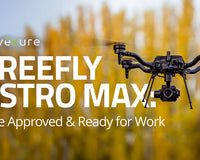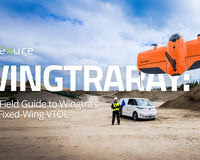As a leader in the drone industry, DJI has consistently pushed the boundaries of innovation, delivering state-of-the-art platforms that redefine what's possible. With the recent release of their new Matrice 350 RTK, we thought we’d explore the key differences between these two capable platforms and examine flight performance, weatherproofing capabilities, battery performance, transmission systems, and other newly upgraded features. If you're wondering if it's worth upgrading to the Matrice 350, this article is for you.
Flight Performance
Both the Matrice 350 RTK and Matrice 300 RTK boast an impressive maximum flight time of 55 minutes, ensuring ample airtime, and exhibit remarkable stability and agility, making them optimal for a wide range of applications, including mapping, surveying, public safety, law enforcement, and infrastructure inspection.However, the Matrice 350 RTK takes the lead in flight performance with its enhanced transmission system and improved safety features, such as the new advanced arm lock indicator, preventing take-off if the arm lock isn't properly secured.

Weatherproofing
When withstanding challenging weather conditions, the Matrice 350 RTK holds an IP55 protection rating and is more resistant to dust and water ingress, ensuring uncompromised performance even in adverse environments. On the other hand, the Matrice 300 RTK offers slightly less weatherproofing at an IP45 rating. If your flight operations involve flying in consistently dusty or wet conditions, the Matrice 350 RTK may be the better option, giving you that added confidence and peace of mind.
Satellite Signal Reception
Both drones offer a selection of global navigation satellite systems (GNSS) for reliable satellite signal reception, including GPS, GLONASS, BeiDou, and Galileo. However, it's worth noting that the Matrice 350 RTK incorporates additional frequency bands, providing a more comprehensive and accurate positioning system. It supports GPS: 11/L2/15, GLONASS: L1/L2, BeiDou: B1/B2/B3, and Galileo: E1/E5.
The Matrice 300 RTK supports GPS: L1/L2, GLONASS: L1/L2, BeiDou: B1/B2, and Galileo: E1/E5. This additional support for frequency bands in the Matrice 350 RTK ensures improved signal reception, resulting in more precise and reliable positioning data.
Transmission System and Range
Both drones offer a selection of global navigation satellite systems (GNSS) for reliable satellite signal reception, including GPS, GLONASS, BeiDou, and Galileo. However, it's worth noting that the Matrice 350 RTK incorporates additional frequency bands, providing a more comprehensive and accurate positioning system. It supports GPS: 11/L2/15, GLONASS: L1/L2, BeiDou: B1/B2/B3, and Galileo: E1/E5.

New TB65 Battery System
One of the most notable upgrades in the DJI Matrice 350 RTK is the introduction of the TB65 Intelligent Flight Battery and the accompanying BS65 Battery Station. This new battery system offers enhanced power and efficiency over its predecessor.
While both drones offer a maximum flight time of 55 minutes (without payload), the TB65 battery offers an increased lifespan with a rating of 400 power cycles, compared to the 200-cycle lifespan of the TB60. This extended lifespan means that the TB65 battery can handle more charge cycles before requiring replacement, translating into reduced operational costs and improved efficiency.
New Aircraft and Battery Cases
DJI has introduced new aircraft and battery cases for the Matrice 350 RTK to enhance portability and convenience. These updates make transportation and deployment of the drone more streamlined and efficient.
The new aircraft case boasts a compact design 31% smaller than the previous model. Its four universal wheels allow easy maneuverability and smooth rolling during travel. The reduced size and improved mobility of the case make it more convenient to transport to different job sites, ensuring that you can quickly set up and deploy.
The battery case, the BS65 Battery Station, accompanies the aircraft case and contributes to the overall enhanced portability. It provides efficient storage and charging capabilities for your TB65 Intelligent Flight Batteries, WB37 RC batteries, and RC Plus. The BS65 Battery Station features multiple charging ports, allowing you to charge multiple batteries simultaneously. Its compact size and efficient organization simplifies the battery management process and reduces the downtime associated with battery replacement and charging.
Payload and FPV Camera
Both the Matrice 350 RTK and Matrice 300 RTK excel in terms of payload capacity, with maximum payloads of 9.15 kg and 9 kg, respectively. This allows for the integration of various professional-grade cameras and equipment. When it comes to the FPV (First Person View) camera, the Matrice 350 RTK offers a higher resolution at 1080p/30fps with a wide field of view (FOV) of 145°, including night vision capabilities. On the other hand, the Matrice 300 RTK provides a resolution of 960p/30fps with the same FOV. If higher resolution and night vision capabilities are a priority for you, the Matrice 350 RTK may be worth the upgrade.
Dimensions and Weight
With dimensions, both the Matrice 350 RTK and Matrice 300 RTK have identical measurements when unfolded, standing at 810x670x430mm. When folded, they maintain the same compactness at 430x420x430mm. The drones also share a similar diagonal wheelbase of 895mm. However, there is a slight variation in weight, with the Matrice 350 RTK weighing 3.77 kg and the Matrice 300 RTK weighing 3.6 kg. This slight difference in weight may not significantly impact the overall performance but is worth considering depending on your specific use case. In our flight testing, we also noticed that the design of the Matrice 350 makes it much easier to fold and unfold the arms than the Matrice 300.

Is it Worth Upgrading to the Matrice 350?
The DJI Matrice 350 RTK and Matrice 300 RTK offer exceptional performance and reliability, catering to a wide range of commercial drone applications. However, the Matrice 350 RTK edges ahead in critical areas such as the battery system, weatherproofing, transmission range, and portability. If you require a drone that can withstand challenging weather conditions, provide an extended transmission range, and deliver precise positioning data, the Matrice 350 RTK may be worth the upgrade. However, if budget is a significant consideration, the Matrice 300 RTK was and still is an incredibly capable platform.
At Advexure, we understand the unique requirements of different industries and can assist you in choosing the right drone platform. Contact us today and speak to our team of SMEs so we can help you find the best platform for your industry or use case.










